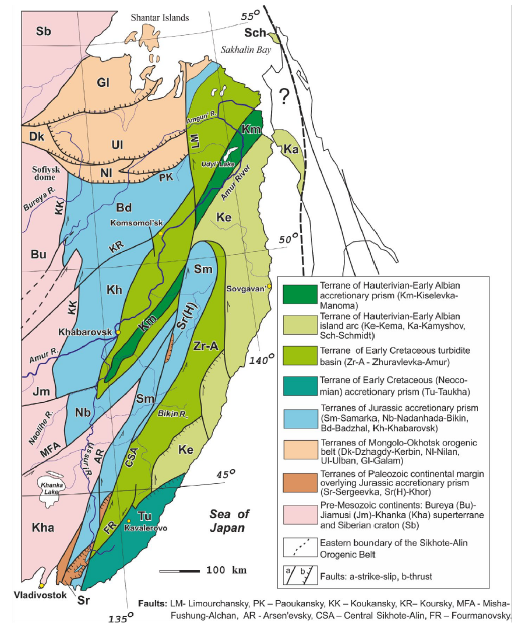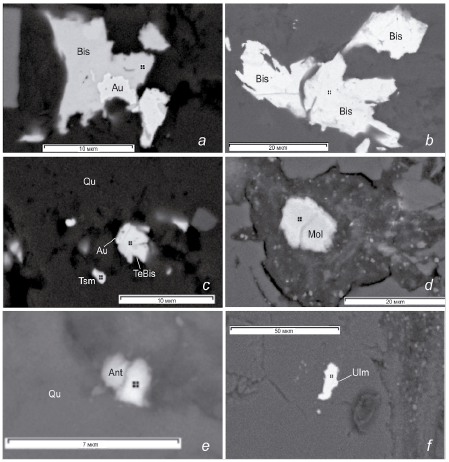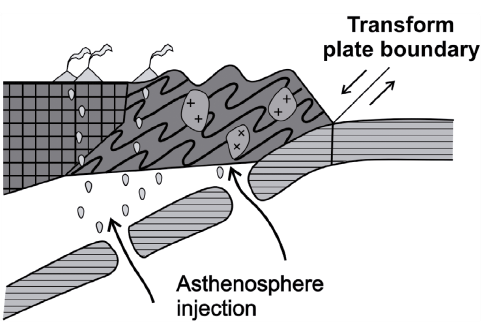1. Introduction
According to the division scheme for the gold-bearing territories of the Russian Far East, the Albazinskoe gold-bearing deposit is situated in the Lower Amur Zone of the Sikhote-Alin gold-bearing province (Moiseenko & Eirish, 1996). Within this mineragenic zone more than ten large and medium-sized deposits are known (Mnogovershinnoe, Belaya Gora, Polyanka, Agni-Afanas'evskoe, Dyappe, etc.) and more than thirty ore-manifestations. Based on the mineralogical composition, ores of deposits are referred to the gold-quartz and gold-sulfide ore-formational types. Gold mineralization of the Lower Amur area is spatially and genetically associated with dikes and different-sized granitoid plutons of heightened basicity, subvolcanic intrusions medium-acidic composition and sometimes with volcanic neck facies, represented by basaltliparite rocks (Izokh et al., 1967; Moiseenko & Eirish, 1996). It is believed that the disposition of gold-bearing deposits in the Lower Amur Zone is subordinated to the regional ore-magmatic zoning, formed either around the orogenic dome that emerged over a deep granitic hearth (Moiseenko & Eirish, 1996; Zvezdov, Mishina, 2010) or around a central type megastructure generated by a mantle plume (Didenko et al., 2010; Moiseenko & Sakhno, 2000; Yushmanov, 2012). According to these opinions, in the central parts of the dome structure (or megastructure), tin and, to a lesser extent, molybdenum, and more rarely high-fineness gold mineralization are developed. In the marginal parts and in non-metamorphosed rocks of the intrusive frame, later gold-quartz mineralization is localized, and on the periphery in the terrigenous rocks low-temperature goldsulfide mineralization with low-fineness gold is formed. In the volcanogenic and subvolcanic formations associated with terrigenous complexes, gold-low sulfide (poor sulfide) mineralization is developed, sometimes with tellurium.
Detailed mineralogical-geochemical studies of the Albazinskoe deposit ores have shown that except sulfides represented by pyrite, arsenopyrite, galena, sphalerite, pyrrhotite, and chalcopyrite, which are usually present at the goldsulfide deposits, the ore minerals of rare metal elements are widely developed at this gold-bearing deposit. These minerals are as following: sulfides of antimony, bismuth and molybdenum, native bismuth, copper, nickel, silver, tellurides of bismuth, cobalt sulphoarsenite, nickel sulphoantimonite, silver sulphobismite, lead-antimony-bismuth sulphosalts, oxides of tin, titanium, tungsten and some others. The presence of minerals of the chalco-and siderophilic elements (Te, Bi, Se, Sb, Sn, Hg, Ni, Co, Mo, W) in the Albazinskoe deposit ores gives us the ground to classify it, according to (Gamyanin, et al., 1998; Goryachev, 2006; Osipov, Sidorov, 1973; Shilo et al, 1972; Volkov et al., 2007, etc.), as gold-rare metallic deposit.
2. Methods of research
The study of ore samples was carried out in polished sections using both traditional mineralogical methods and modern methods of investigating of the material composition. The first group of methods included the study and identification of ore and non-metalliferous minerals under the optical microscope in reflected light based on physical, morphological and optical properties of minerals, their texture and structural features, as well as the relationships of individual ore minerals and their assemblages. The second group of methods was used for determination of the elemental composition of the minerals and for recalculating the obtained data into crystalochemical formulas. The elemental composition of ore minerals was determined by applying a scanning electron microscope EVO-50 XVP with an energy dispersive X-ray spectrometer INCA-350 at the laboratory of Micro- and Nano-Research of the Far Eastern Geological Institute of the Far Eastern Branch of the Russian Academy of Sciences. Scanning electron microscope was operated at acceleration voltage 20 kV and resolution 1 um, analyst Kemkin I.I. The following standards were used: for S, Fe - FeS2 10-Jul-2008 03:47 PM, Co - Co 10-Jul-2008 03:31 PM, Ni - Ni 1-Jun-1999 12:00 AM, As - InAs 1-Jun-1999 12:00 AM, Sb - Sb 1-Jun-1999 12:00 AM, Se - Se 1-Jun-1999 12:00 AM, Pb - PbF2 1-Jun-1999 12:00 AM , Bi - Bi 1-Jun-1999 12:00 AM, Ag - Ag 1-Jun-1999 12:00 AM, Te - HgTe 1-Jun-1999 12:00 AM, Cu - Cu 1-Jun-1999 12: 00 AM.
3. Brief geological setting
The Albazinskoe gold-bearing deposit is located on the left bank of the estuary part of the Amur river in the interfluve of its left tributaries Amgun' and Somnya (Khabarovsk region). Structurally the deposit is situated within the Ul'ban terrane of the Jurassic turbidite basin of the Mongolo-Okhotsk orogenic belt (Figure 1). The territory of the Albazinskoe deposit is composed of the Jurassic terrigenous strata that are intruded by Late Cretaceous plutons and subvolcanic bodies of diorites, granodiorite- and granite-porphyrites and rhyodacites. The ore bodies of the deposit are formed by conjugated dikes of the above magmatic rocks and consist of sericite-carbonate-quartz metasomatites, brecciated rocks with streaky-impregnationed quartz-sulphide mineralization and silicified sandstones with impregnations of sulphides. The deposit belongs to the gold-quartz poor-sulphide ore-formational type (Moiseenko & Eirish, 1996) and is characterized by a small amount of ore minerals, the content of which is 1-5%.
The most common ore minerals of the deposit are pyrite and arsenopyrite. Less common ore minerals are marcasite, galena, sphalerite, pyrrhotite, chalcopyrite, scheelite and fahlores. The vein minerals are quartz, feldspars, carbonates, chlorite, and mica.
4. Main research results and discussion
In order to clarify minerals that concentrate gold mineralization the mineralogical and geochemical studies of ores of the Albazinskoe deposit have been carried out. As a result, we have revealed about twenty ore minerals that were not described in this deposit earlier. Among them there are sulfides, tellurides, selenides, sulphosalts, sulphoarsenites, sulphoantimonites, sulphobismuthites, tungstates and oxides of such metals as bismuth, antimony, molybdenum, cobalt, nickel, lead, silver, tin, titanium, tungsten and some others. Several elements (Bi, Cu, Ni, Ag) were also found in a native form. A brief description of some newly discovered minerals is given below.
Bismuthine (Bi2S3) is one of the most common minerals at the deposit. It occurs both as isolated grains and in intergrowth with other ore minerals. In the form of isometric inclusions it forms a rare impregnation within the allotriomorphic grains of chalcopyrite. Bismuthine closely intergrows with native gold (Figure 2a), containing an admixture of mercury up to 4.39 wt. %. The boundaries between these minerals are rectilinear, less often meandering, which indicates their near-simultaneous crystallization. In addition, bismuthine is found in intergrowth with the iron hydroxides, in which it forms elongated and angular inclusions. Often bismuthine forms an agglomeration of grains, which have amoeboid shape (Figure 2b). The size of individual grains does not exceed 5 um, and mineral aggregations of 20 µm.
The data on the chemical composition of bismuthine (Table 1) demonstrate the presence of impurities in its crystalline lattice in the form of atoms of iron - 1.02 - 5.11 wt. % , stibium - 2.8 - 3.31 wt. % , selenium - 1.32 - 2.47 wt. % and silver - 2.44 wt. %. The calculated crystalochemical formulas of bismuthine correspond to the theoretical ones, but with a slight sulfur deficit, for example - Bi2.05S2.95 or (Bi1.76Fe0.14Sb0.13)2.03(S2.82Se0.15)2.97 .
Table 1 Chemical composition of minerals of bismuth, antimony, nickel, cobalt, silver and lead
| Sample | Element (wt. %) | Mineral | ||||||||||
|---|---|---|---|---|---|---|---|---|---|---|---|---|
| Ni | Co | Sb | As | S | Fe | Bi | Pb | Ag | Se | Cu | ||
| An5-46/1 | 2,80 | 19,00 | 1,02 | 77,18 | Bismuthine | |||||||
| An5-55/1 | 16,73 | 2,89 | 76,22 | 2,44 | 1,72 | Bismuthine | ||||||
| An5-57/1 | 17,01 | 5,11 | 76,56 | 1,32 | Bismuthine | |||||||
| An5-59/1 | 3,31 | 18,29 | 1,54 | 74,38 | 2,47 | Bismuthine | ||||||
| An5a-63/1 | 16,93 | 0,73 | 78,88 | 2,01 | 1,33 | Bismuthine | ||||||
| An5a-64/1 | 18,07 | 81,93 | Bismuthine | |||||||||
| An5a-64/2 | 18,08 | 79,13 | 2,79 | Bismuthine | ||||||||
| An5a-66/1 | 3,44 | 18,55 | 76,94 | 1,08 | Bismuthine | |||||||
| An5a-67/1 | 2,94 | 18,45 | 76,79 | 1,82 | Bismuthine | |||||||
| An5a-73/1 | 16,55 | 3,56 | 75,27 | 2,11 | 2,50 | Bismuthine | ||||||
| An5a-74/5 | 17,26 | 76,76 | 2,77 | 3,21 | Bismuthine | |||||||
| An5a-80/2 | 1,39 | 18,07 | 77,69 | 1,37 | 1,47 | Bismuthine | ||||||
| An2c-9/1 | 5,76 | 16,09 | 4,39 | 45,77 | 27,00 | Matildite | ||||||
| An2c-10/1 | 6,78 | 15,50 | 5,72 | 46,68 | 25,32 | Matildite | ||||||
| An2-14/1 | 9,94 | 16,49 | 0,72 | 33,32 | 35,53 | 1,64 | Kobellite | |||||
| An2-14/9 | 9,31 | 18,66 | 0,86 | 31,05 | 38,22 | 1,13 | Kobellite | |||||
| An2-14/9a | 9,16 | 17,96 | 0,94 | 30,16 | 39,14 | 0,98 | Kobellite | |||||
| An2-9/1 | 25,18 | 1,05 | 56,18 | 2,49 | 15,06 | Ullmannite | ||||||
| An2-10/1 | 26,21 | 1,51 | 54,64 | 2,76 | 14,89 | Ullmannite | ||||||
| An3-4/1 | 2,70 | 20,42 | 42,13 | 22,56 | 6,82 | Cobaltite | ||||||
| An4-25/1 | 5,73 | 21,75 | 43,77 | 21,18 | 7,57 | Cobaltite | ||||||
| An3-16/3 | 4,44 | 23,46 | 46,24 | 20,00 | 5,52 | Cobaltite | ||||||
| An3-26/1 | 5,48 | 22,54 | 46.39 | 20,10 | 5,49 | Cobaltite | ||||||
| An3-29/1 | 7,28 | 21,80 | 47,59 | 19,85 | 3,48 | Cobaltite | ||||||
| An3-29/9 | 70,98 | 28,05 | Antimonite | |||||||||
| An5-22/1 | 71,55 | 28,45 | Antimonite | |||||||||
| An2a-11/1 | 31,39 | 18,80 | 1,33 | 48,46 | Heteromorphite | |||||||
| An2a-12/1 | 30,94 | 18,87 | 1,29 | 48,87 | Heteromorphite | |||||||
| An2a-6/3 | 30,34 | 2,73 | 21,01 | 7,48 | 38,38 | Jamesonite | ||||||
| An2a-7/2 | 33,99 | 20,98 | 4,36 | 40,63 | Jamesonite | |||||||
| An2a-7/4 | 33,04 | 21,02 | 4,85 | 41,09 | Jamesonite | |||||||
| 1D-32-1/1 | 99.25 | 0.75 | Native Ni | |||||||||
| 1D-32-1/2 | 99.38 | 0.62 | Native Ni | |||||||||
| 1D-44-1/1 | 99.07 | Native Ag | ||||||||||
| 1D-44-1/2 | 96.06 | Native Ag | ||||||||||
| 1D-45-1/1 | 97.9 | Native Cu | ||||||||||
| 1D-45-1/2 | 98.2 | Native Cu | ||||||||||
| 1D-18-1 | 91.68 | Native Bi | ||||||||||
| An5-28-1 | 93.66 | Native Bi | ||||||||||
Table 2 Chemical composition of minerals of bismuth-tellurium, molybdenum and tin
| Sample | Element (wt. %) | Mineral | |||||||
|---|---|---|---|---|---|---|---|---|---|
| Mo | Sn | Mn | O | S | Fe | Bi | Te | ||
| An4-40/1 | 61,34 | 38,42 | Molybdenite | ||||||
| An4-41/1 | 61,83 | 37,20 | Molybdenite | ||||||
| An5-11/1 | 76,61 | 20,52 | 2,84 | Cassiterite | |||||
| An5-12/1 | 74,97 | 21,86 | 3,19 | Cassiterite | |||||
| An5-16/1 | 75,81 | 21,23 | 2,93 | Cassiterite | |||||
| An4-30/1 | 53,31 | 46,38 | Tellurobismuthite | ||||||
| An4-30/9 | 51,99 | 46,75 | Tellurobismuthite | ||||||
| An4-28/1 | 54,48 | 45,53 | Tellurobismuthite | ||||||
| An4-28/9 | 51,72 | 47,22 | Tellurobismuthite | ||||||
| An5-40/1 | 82,93 | 17,07 | Hedleyite | ||||||
| An5-40/9 | 81,78 | 18,22 | Hedleyite | ||||||
| An5-50a/1 | 58,49 | 41,51 | Tsumoite | ||||||
| An5-50a/9 | 46,25 | 53,75 | Tsumoite | ||||||
| An5-51/9 | 61,13 | 38,44 | Tsumoite | ||||||
Tellurobismuthite (Bi2Te3) is present in the form of monomineral inclusions up to 3 um in quartz. The shape of mineral grains is isometric, elongated, angular (Figure 2c). Tellurobismuthite also occurs in intergrowths with sulphobismutites of lead, along with which it replaces idiomorphic crystals of cobalt-bearing (up to 1.78 wt. %) arsenopyrite. The replacement of arsenopyrite takes place both from the inside and from the periphery of crystals. The results of chemical analysis of tellurovismutite are satisfactorily recalculated to the formulas Bi205Te2 95 or Bi211 Te289, although a slight excess of bismuth is observed in this mineral (Table 2).
Hedleyite (Bi7Te3), analogously as tellurovismutite, forms an isolated monomineral rounded grains in quartz. The size of grains is up to 10 um. The recalculation of data of chemical composition of this mineral to the theoretical formula (Bi7.48Te2.52) also shows a heightened amount of bismuth in its crystalline lattice.
Tsumoite (BiTe) occurs in the form of small (not more 2 um) rounded or slightly elongated mineral grains (Figure 2c). Often congestions of tsumoite grains are spatially associated with native gold, tellurovismutite and sulphobismutites of lead. The calculated crystalochemical formula of tsumoite corresponds to Bi0.93Te1.07.
Molybdenite (MoS2) is a rare mineral of the deposit and occurs both in the form of thin-scaly congestions and aggregates of leafy or rosette-like form (Figure 2d). Usually molybdenite is located in sericite-carbonate-quartz veins and veinlets, in which it forms a pocket-like congestions up to 15 um in size. The calculated crystalochemical formula of molybdenite corresponds to the theoretical one (Table 2).
Antimonite (Sb2S3), analogously as molybdenite, occurs in the form of isolated isometric and lamellar inclusions in quartz, the size of which varies from 1 to 3.5 um (Figure 2e). The calculated crystalochemical formula of antimonite corresponds to the theoretical one.
Ullmannite (NiSbS) is found in the form of isolated single grains in metasomatically changed rocks. The intergrowths with other ore minerals are not observed. Ullmannite is characterized by allotriomorphic grains, which have both isometric and elongated shapes (Figure 2f). The size of elongated grains is 15x8 um and isometric ones is 3 - 5 um. The grain boundaries are sinuous, slightly jagged. Chemical composition of the ullmannite is characterized by stoichiometry (Table 1) and corresponds to the extreme ullmannite series. The chemical analyses data demonstrate the presence of impurities of cobalt (up to 1.51 wt. %) and arsenic (up to 2.76 wt. %), which, obviously, isomorphically replace nickel and antimony in the crystalline lattice. The calculated on 3 atoms crystalochemical formulas of the ullmannite are as follows: (Ni0.91Co0.04)0.95(Sb0.98As0.07)105S1.0 and (Ni0.94CO0.05)0.99(Sb0.95AS0.08)1,03 S0.98, which corresponds to the theoretical composition.
Cobaltite (CoAsS) is much more common than ullmannite. Taking into account the morphology of mineral grains and their size and also relationships of this mineral with other minerals, two generations of cobaltite are distinguished in the ores of the Albazinskoe deposit. Cobaltite of the first generation occurs in the form of rounded (less often lenticular) grains (Figure 3a) in the cobalt-bearing pyrite and non-metalliferous minerals. The size of such grains does not exceed 3 um. Cobaltite 1 forms also a relict rims (Figure 3b) up to 1 um in thick around grains of pyrite containing inclusions of galena, which indicates its earlier crystallization.
Cobaltite of the second generation (Figure 3c, d), on the contrary, is present in the form of idiomorphic crystals with well-defined crystallographic shapes of cubic and octahedral habitus. The average crystals size is 10-20 um. The boundaries of cobaltite 2 with other minerals always are clear and straight. Cobaltite 2 often contains inclusions of chalcopyrite and sphalerite, with which forms close intergrowths in most cases. Sometimes cobaltite 2 develops upon the pyrite and, thus, replaces it.
The study of chemical composition of the different-aged cobaltite generations showed that they also differ by the content of the main chemical elements (cobalt, arsenic and sulfur), and impurity elements (iron and nickel). Chemical composition of the cobaltite 1 (An3-4/1 and An4-25/1, Table 1) is characterized by heightened iron contents (up to 7.57 wt. %) and low contents of nickel. Crystalochemical formulas of the cobaltite 1 are as follows: (Co0.58Fe0.21Ni0.08)0.87As0.95S1.18 or (Co0.60Ni0.16Fe0.22)0.88As0.95S1.07.It should be noted a slight deficit of cobalt and arsenic and excess of sulfur compared with the theoretical composition.
The chemical composition of cobaltite 2 (An3-16/3, An3-26/1, An3-29/1, Table 1) includes the same list of isomorphically substituting components, but the concentrations of them is significantly differ. Cobaltite 2 is characterized by high concentrations of nickel (up to 7.28 wt. %), but iron contents is significantly lower (up to 3.48 wt. %) compared with cobaltite 1. It should be also noted somewhat heightened contents of the main components (cobalt and arsenic) in cobaltite 2 compared with cobaltite 1. As a whole, cobaltite 2 is characterized by a slight deficit of elements in the cationic group, and, on the contrary, an excess in the anionic group. The calculated crystalochemical formula of the cobaltite 2 corresponds to (Co0.61-0.66Fe0.10-016Ni0;13-0.21)0.92-0.95 AsL01-L05SL03-0.04. The As/S ratio for different-aged cobaltite generations also differs and makes up 1.9-2.1 for the cobaltite 1, and 2.3 for the cobaltite 2. Thus, from the early to late generations of cobaltite the concentrations of sulfur and iron are decrease, but the contents of cobalt, nickel and arsenic are increase.
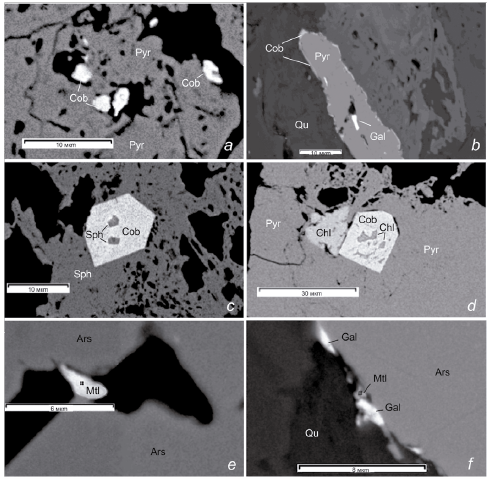
Figure 3 Morphology of grains and character of intergrowths of minerals of the cobalt, silver and lead. The samples numbers: a - An3-4/1, b - An3-16/3, c - An3-29/1, d - An3-26/1, e - An2c-9/1, f-An2c-10/1.
In addition, cobalt and nickel are also found in the form of an impurity in arsenopyrite and pyrite. The content of cobalt in the relic grains of arsenopyrite is up to 2.34, and in pyrite up to 3.51 wt. %. The content of nickel is up to 1.85 and up to 2.32 wt. %, respectively.
Matildite (AgBiS2) is a rare mineral in the Albasinskoe deposit ores. It was found in the arsenopyrite grains voids in the form of allotriomorphic inclusions up to 3 um in size (Figure 3e). The boundaries between these minerals are corrosional in most case that indicates a later crystallization of matildite. Beside that, the close intergrowths of matildite and galena along the grain boundaries of arsenopyrite are also observed (Figure 3f). The size of matildite grains does not exceed 1-1.5 um. It is noteworthy that the galena associated with matildite contains an impurity of silver up to 6 wt. %, while the matildite is devoid of lead, but it contains impurities of iron and arsenic (Table 1). According to the chemical analyses data the crystalochemical formula of the ascertained matildite is (Ag0.88Fe0.28)u6(Bi0.79As0.27)1.06S1.78.
Kobellite (Pb6FeBi4Sb2S16) occurs very rare. It is observed in the form of isolated isometric grains with jagged outlines in metasomatic rocks. The intergrowths of kobellite with other ore minerals have not been seen. Recalculation of the chemical analysis data (Table 1) on 29 atoms corresponds to the following formula (Pb5.15Cu0.78Fe0.39)6.32Bi4.78Sb2.45S15.45, that clear show a slight impuritiy of copper in this mineral.
Jamesonite (Pb4FeSb6S14) is more common than kobellite in the ores of the deposit. It was found in the central parts of arsenopyrite grains conjointly with galena and antimony-bismuth sulphosalts of lead. Jamesonite forms a rounded grains and elongated aggregates up to 2 - 5 um in size. The data of chemical composition of this mineral (Table 1) show that the contents of main mineral-forming components (lead, stibium and sulfur) vary insignificantly, but the concentration of iron is higher than in theoretical crystalochemical formula (from 4.35 to 7.48 wt. %). The averaged calculated crystalochemical formula of the jamesonite corresponds to Pb4.06Fe1.61Sb5.78S13.55.
Heteromorphite (Pb7Sb8S19) is mainly developed in sulfide minerals in the form of elongated-prismatic crystals with slightly rounded facets. The grains size varies from 2.5 to 5 um. Heteromorphite is also found in host metasomatic rocks in the form of isolated grains. This mineral has a near-theoretical chemical composition, although in some grains the impurity of iron (up to 1.33 wt. %) is observed (Table 1). Crystalochemical formula of the ascertained heteromorphite is as follows - (Pb698Fe074)772Sb8 03S1a25. The character of the interrelationships between the above-mentioned sulphoantimonites of lead and antimony-bismuth sulphosalts with other ore minerals indicates their later crystallization with respect to the main sulfides.
Cassiterite (SnO2) is found in pyrite grains in the form of prismatic, wedge-like, and less often isometric shape debris (Figure 4a). The size of debris is 3 - 6 um. According to the chemical analysis this cassiterite is characterized by present of iron impurity (Table 2).
Native metals (Ni, Ag, Cu, Bi) occur in the form of isolated grains of allotriamorphic and near isometric form (Figure 4b-d). Their sizes range from 0.7 to 18 um. These minerals do not form intergrowths with other ore minerals, as well as with each other. Usually they fill voids in the quartz, calcite or are located in the intergranular space in metasomatites. The chemical analysis data (Table 1) demonstrate their exceptional chemical purity, with the exception of native nickel. The individual grains of this mineral are characterized by a zonal structure, which is fixed by the differences in color shades of central and marginal parts of grains (Figure 4b). Data of chemical analysis show that the marginal (a lighter shade) areas of such grains contain sulfur up to 0.62 wt. %, but are devoid of iron, while the central (a darker) areas, on the contrary, contain iron up to 0.75 wt. % and sulfur free.
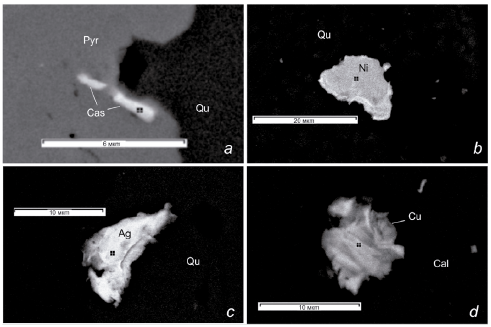
Figure 4 Morphology of grains and character of intergrowths of minerals of the tin and native metals. The samples numbers: a - An5-16/1, b - 1D-32-1/1, c - 1D-44-1/1, d - 1D-44-1/2.
The revealed features of mineral composition of ores of the Albazinskoe deposit and geochemical specificity of ore minerals indicate its belonging to the gold-rare metallic ore-formational type. Previously deposits of such formational type were not described within the Lower Amur Zone (as it is known (Moiseenko & Eirish, 1996), all gold-bearing deposits and ore-manifestations in the area of lower stream of the Amur River have been attributed either to gold-quartz or gold-sulphide ore-formational types).
Gold-rare metallic deposits are widely distributed and well studied (Gamyanin et al., 1998; Goryachev, Goncharov, 1995; Lang et al., 2000; Newberry et al., 1995; Osipov, Sidorov, 1973; Shilo et al., 1972; Volkov et al., 2007 and references in them), which made it possible to identify a number of characteristic criterions for them. Besides the mineralogical-geochemical individuality of ores, the form of gold mineralization is also very indicative. At the Albazinskoe deposit (as well as at other deposits of this type) gold is present in the form of fine-dispersed impregnations and submicroscopic grains in arsenopyrite, less often in other sulfides, as well as in native bismuth and tellur-bearing minerals. The other identification characters of the gold-rare metallic deposits are structural-morphological types of ore bodies. As a rule, ore bodies are represented by simple or branching veins (or series of closely located veins) conjugated with dykes and subvolcanic bodies of granodiorite-granites and which are composed of sericite-carbonate-quartz metasomatites, and / or by tectonized metasomatic zones (mineralized crushed zones) comprising streaky-impregnationed mineralization and which are superimposed on granitoid dykes and subvolcanic bodies and surrounding terrigenous rocks. More often a combination of crushed zones and metasomatic veins take place.
The present of a significant amount of minerals of the chalco- and siderophile elements in the ores of gold-rare metallic deposits allows us to presuppose that the source of magmatic melts generating ore mineralization is located much deeper than the depleted upper mantle. Such source can be asthenospheric injections (Figure 5) penetrating through a ruptures in a subducted oceanic plate (so-called slab-windows) (Khanchuk, 2000; Khanchuk, Ivanov, 1999; Cao et al., 2017; Peng et al., 2018). The arrising of ruptures is explaned by changing of a geodynamic mode of subduction of an oceanic plate to a geodynamic mode of its sliding along continent margin (Khanchuk, 2000; Khanchuk et al., 2016; Peng et al., 2018). The changing of direction of an oceanic plate motion with respect to the continental margin is resulted in large-scale lithosphere extension, it thinning and tearing that is led to the upwelling of asthenospheric material.
In the south of the Far East of Russia (Primorsky and Khabarovsk Territories), the number of the gold-bearing deposits attributed to the gold-rare metallic ore-formational type is not large so far (probably because of insufficient investigation of the mineralogical composition of the ores). An important feature of these deposits is that they are spatially and genetically related to the late Cretaceous-Paleogene granitoids (Gvozdev et al., 2016; Dobroshevsky et al., 2017; Lotina, 2011) whose petro-geochemical characteristics correspond to the A-type granitoids (Khanchuk, 2006; Grebennikov et al., 2016). In the recent publications devoted to the A-type granitoids are pointed out that they are formed within the continental margin under conditions of large-scale lithosphere extension that is caused by a geodynamic mode of very slight oblique subduction or parallel (transform) sliding of an oceanic plate with respect to the continent (Frost, Frost, 2011; Grebennikov, 2014; Peng et al., 2018, etc.).
The geodynamic mode of the convergent (subduction) continental margin for the late Cretaceous-Paleogene time at the eastern margin of the Paleo-Asian continent is reconstructed based on the set of other geological data (Khanchuk, 2006; Grebennikov et al., 2016; Kemkin et al., 2016; Khanchuk et al., 2016, etc.). As for the northern margin of the Paleo-Asian continent, the geodynamic mode of transform margin took place here from the Middle Cenomanian time due to the sublatitudinal orientation of boundary of the continental and oceanic plates (Figure 6) (Khanchuk, 2006; Kemkin et al., 2016; Khanchuk, 2000; Khanchuk et al., 2016) Thus, the mediated genetic relationship between the formation of gold-rare metallic mineralization and the geodynamic mode of the sliding of the lithospheric plates is observed.
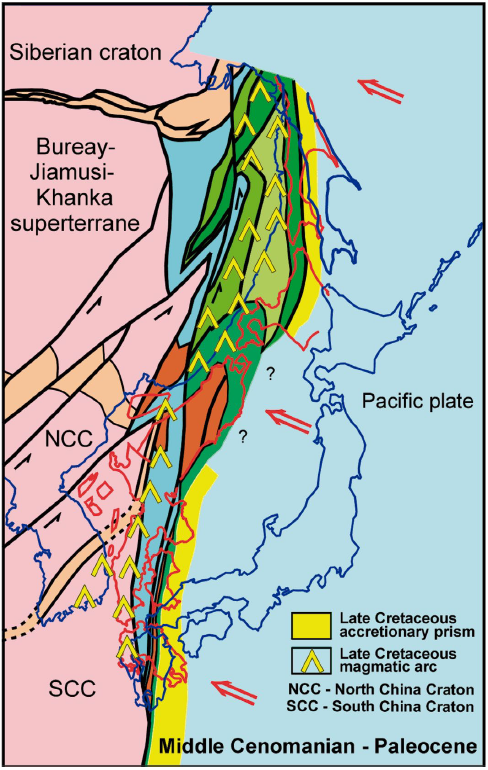
Figure 6 Paleogeodynamic reconstruction on the Middle Cenomanian - Paleocene time (after Kemkin et al., 2016)
To further validation of this revealed regularity, an additional more detailed investigations of petrology, geochemistry and geochronology of the associated with gold-rare metallic mineralization granitoids are required.
5. Conclusion
Mineralogical-geochemical investigations of the ores of the Albazinskoe gold-bearing deposit have shown that besides the traditional sulfides of iron, arsenic, copper, lead and zinc, containing fine-dispersed impregnations and submicroscopic grains of native gold, there is a wide range of minerals of rare metallic elements, many of which are also form an intergrowth with microscopic gold disseminations.
The presence in the ores of the Albazinskoe deposit of minerals of the chalco- and siderophilic elements (Te, Bi, Se, Sb, Sn, Hg, Ni, Co, Mo, W) gives the basis to classify it as gold-rare metallic. Previously, deposits of such formational type were not described within the Lower Amur Zone of the Sikhote-Alin gold-bearing province. In contrast, all gold-bearing deposits and ore-manifestations in the area of lower stream of the Amur River have been attributed either to gold-quartz or gold-sulphide ore-formational types.
The spatial and genetical relationship of the gold-rare metallic deposits with the granodiorite-adamellit-granite rocks, which is revealed in the Far East of Russia and also other regions, indicates that their formation is related with the geodynamic mode of sliding of lithospheric plates.













